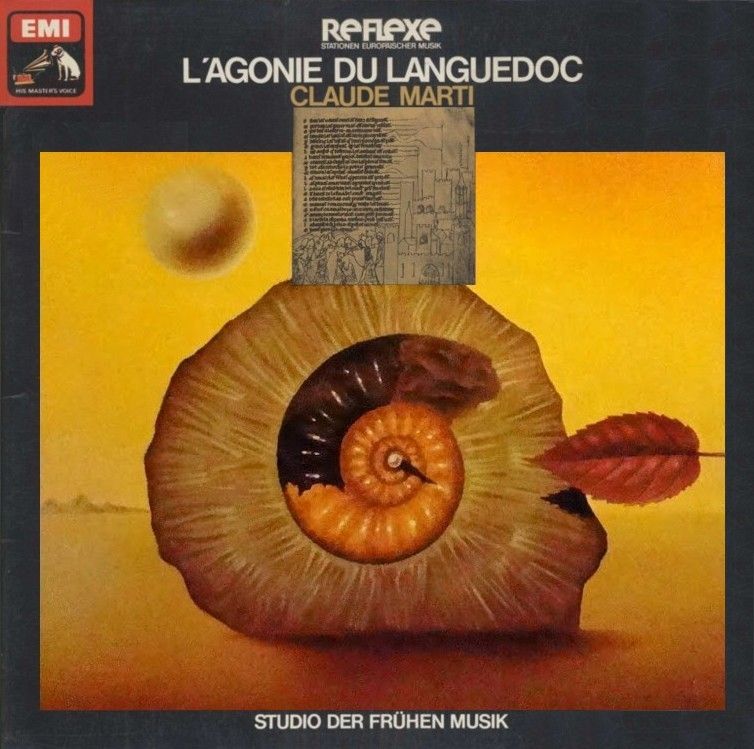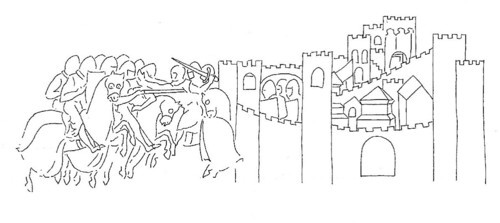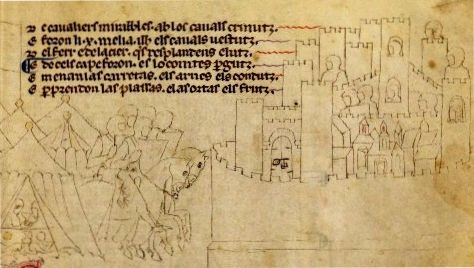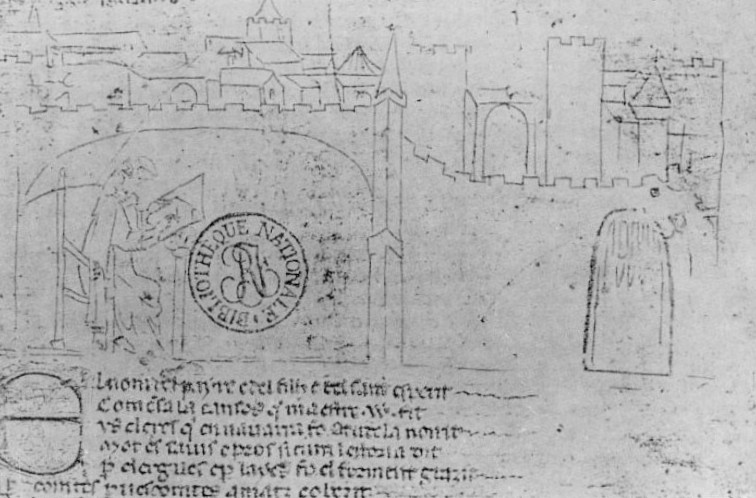
medieval.org
LP, 1975: EMI Reflexe 1C 063-30132
CD, 1990: EMI Classics 8 26500 2

medieval.org
LP, 1975: EMI Reflexe 1C 063-30132
CD, 1990: EMI Classics 8 26500 2
Seite 1
1. Pèire CARDENAL. Tartarassa ni voutor [7:18]
(mit rezirtierten Texten aus dem
Aiso es la cansos de la crozada contr els ereges dalberges
von Guilhem Tudèla und anonymen Texten)
Sängerin, Laute, Sänger, Instrumentalensemble & Rezitation
2. Pèire CARDENAL. Ben volgra [8:09]
(mit rezirtierten Texten aus
Guilhem Augier: Quaus plor e planh
[planctus a la mort de Raimond-Roger, Béziers]
und
Benhart de la Barta: Foilla ni flors)
Sänger-Altus, Fidel, Sänger, Instrumentalensemble & Rezitation
3. Pèire CARDENAL. Razos es qu'ieu m'esbaudei [12:47]
Sänger & Instrumentalensemble
Seite 2
4. Guilhelm FIGUEIRA. D'un sirventes far [2:33]
Chanteur und Gitarre
5. TOMIER & PALAZI. Si col flaca molins torneja [7:15]
Chanteur und 2 Gitarren
6. Pèire CARDENAL. L'afar del comte Guió [8:49]
Sänger & Instrumentalensemble
7. Pèire BREMON RICAS NOVAS. Ab marrimen [5:30]
Chanteur und 2 Gitarren
8. Bernart SICART MARJEVOLS. Ab greu cossire [3:48]
Rezitation und Laute

Claude Marti – Chanteur und Rezitation
STUDIO DER FRÜHEN MUSIK
Thomas Binkley
Andrea von Ramm, Sängerin – Organetto
Richard Levitt – Sänger, Schlaginstrumente
Sterling Jones – Streichinstrumente
Thomas Binkley – Zupfinstrumente
mit:
Benjamin Bagby – Sänger
Harlan Hokin – Sänger
Alice Robbins – Streichinstrumente
Paul O'Dette – Zupfinstrumente
Instrumente:
Organetto, Fideln, Lira, Rabel saracenica, Chitarra saracenica, Gitarren,
Gittern, Lauten, Schellenbaum, Tamburin, Klapper, Trommel

[CD]:
Aufgenommen: 28.VI.-1.VII.1975, Basel, Münstermuseum
Produzent: Gerd Berg
Tonmeister: Joahann-Nikolaus Matthes
Verlag: Manuskript
Titelmotiv: Chanson de la croisade albigeoise
Illustrationen Innenseiten: Chanson de la croisade albigeoise
Cover-Design: Roberto Patelli
Litho: Repro Schmitz KG, Cologne
Ⓟ 1974 EMI Electrola GmbH
Digital reamastering Ⓟ 2000 by EMI Electrola GmbH
© 2000 by EMI Electrola GmbH

L'Agonie du Languedoc
This recording offers
something very new in Early Music recordings: the combination of 13th
century troubadour in its original ambiente, and modern chanteur in the
Langue d'Oc of today. The revitalization of this ancient language today
makes this unusual combination possible; the texts are all original 13th
century poems, yet when Claude Marti is singing these texts he is
thinking of today's Languedoc, striving once again after seven
centuries, for its deserved cultural independence, which was lost in
this Albigentian Crusade. We hope that this unusual combination of
musical genres will offend the devotees of neither field, but rather
will direct the attention to the continuity of this forgotten culture.
The Early Music Quartet
revives here songs concerned with a devastating French invasion of
Languedoc, which began in 1209 and which systematically destroyed in the
cruelest manner the towns, chateaux and monasteries of the South,
thereby breaking apart the old and established social structure which
had provided Europe with its most advanced civilization after that of
the Spanish Arabs. As Ibn Khaldûn (14th century) wrote in the Muqaddimah:
"A nation that has been defeated and has come under the rule of another
nation will quickly perish." So it was with Languedoc, today a
forgotten country of the Middle Ages. This was the homeland of the
troubadours, the cradle of culture in Europe, whose literature remains a
cornerstone of Western lyric. "Troubadour" is the French word, French
the conquerors' language. In Occitanian the word is "trobador". This
language, which is a mixture of several Latin dialects and might as well
be called Old-Provençal, Occitan or Langue d'Oc was, an outgrowth of
the vernacular Latin as spoken in the "Gallia Narbonensis" and in
"Aquitania", with the Atlantic on the west, Italy on the east, the
Central Massif on the north and the Mediterranian on the south:
Gascogne, Limousin, Languedoc, Auvergne, Périgord and Velay are the
areas where the language is spoken. At the time of trobadores the
language was one with Catalonian, and even today the regional dialects
clearly belong together, one language, not French and not Castilian.
It
was the language of Frédéric Mistral who won a Nobel prize for
literature in 1904, and it is the language of a large group of
poet-singers today, the "Chanteurs Occitans", who cultivate the chanson
with political overtones in their own language; a group of modern
trobadores who are carefully watched by a government fearful of their
separatist tendencies.
Claude Marti is one of these
chanteurs, certainly the best-known. During the day he teaches in a
village school and during the summer season he sings nightly in concerts
throughout the South. He is not a worldly man, and when he sings about
minorities that have been forbidden cultural rights (L'Express
observed recently that Japan has two university chairs for Occitanian
and one for Provençal while France has none!) he is simply singing about
himself and his own Occitanian minority.
The Early Music Quartet
and Marti join hands on this recording. His living language, his
identification with the same cause as his ancestors blend with the
revival of the historical music and give life and immediacy to the
collection of songs. The Early Music Quartet brings original trobador
songs while Marti takes original trobador texts and sings them in his
own musical style. No music has survived for the texts that Marti sings
here, and although seven centuries lie between the original music of the
trobadors and today, the power of the language convincingly bridges
this hiatus. For it is not the musical style, it is the anger, despair
and helplessness at the ravaging of the Languedoc, the frustration of a
people subjected to a cultural starvation economy that unites the pieces
on this recording; magnificent poetry which has outlived that forgotten
war, the Albigentian Crusade.
This recording is not a song recital; it is an attempt to portray the art and the feelings of a civilization about to die.

THE ALBIGENTIAN CRUSADE
"Kill them all, God will recognize his own!"
There
in Béziers, 22 July 1209 the crusading army murdered the entire
population of the town, Christians and Cathars alike, took what there
was to take and burned what would burn. The first action (campaign) of
the army of Abbot Arnaud-Amaury de Cîteaux was complete!
The
events leading up to this slaughter are not complicated, they are simply
ordinary political history. At the Council of Toulouse in 1199 the
Cathars, a harmless, aescetic Paulician sect was declared heretical. In
1204 the new Pope, Innocent III decided upon active persecution of the
heretics. Count Raimond VI of Toulouse (Languedoc) was not active in
suppressing them, and the Papal Legate, Pierre de Castelnau was
successful in bringing about a Papal ban on the Languedoc. On 15 January
1208 Pierre de Castelnau was murdered, a crime unsolved to this day.
Innocent III then called for a crusade against Languedoc — how else
might he exercise his power if his ban be ignored and his legate killed?
Thus the highly cultivated, most civilized part of Europe was offered
to the Northern brigands for the taking on the scanty justification that
Raimond VI was insufficiently zealous in persecuting a small minority
within his lands. The Abbot Arnaud-Amaury in Lyon began to organize an
army which led to the disastrous rape of Provence and the Languedoc,
which began the following year with the razing of Béziers. After Béziers
the crusaders, who included the most powerful barons of the North,
moved on to Carcassonne, where the citizens were permitted to leave the
city alive but naked, and all their belongings became the property of
the French crusaders. But these were the lands of the Viscount
Raimond-Roger Trencavel, and the counts of the North felt
uncomfortable about taking them over from the hand of an abbot. Indeed,
can the church take the lands from one count and give it to another?
Burgundy and Nevers and Saint-Pol thought not, and decided to leave the
crusade. Only one was found who in pious humility would accept the
poisoned gift from Rome of such magnificent wealth — Simon, Count of
Leicester and Montfort.
Simon thus became the leader of the
crusade, and he supplemented his army after the departure of his more
powerful colleagues with mercenaries from many places. Simon turned to
the chateau of Bram. There he sent the defenders off in a long chain of
human misery, blinded and with their noses cut off, with a one-eyed man
to lead them, off they went to Cabaret. In the wake of such cruelty, who
would dare to defend his house, who would fail to open his gates to
welcome the cleansing crusaders? Minerve: there he burned 140; Termes,
Cabaret, Lavaur, where he burned between three and four hundred, Cassés
and Castelnaudry, only sixty, and then a grand massacre at Moissac, and
then Muret... on and on.
Pierre de Vaux-Cemai: "Innumerabile etiam haereticas peregrini nostri cum ingenti gaudio combusserunt"
(Historia Albigensium, cap. LII).
In the Statutes of Pamier
Simon set forth the organization of his conquests ... what did it
matter to him that much of the land belonged to the English crown, some
to Philippe Augustus and some to Peter of Aragón? What did the law
matter to him? He was master there now, hated and reviled and feared.
Soon his army was to stage a sensational victory over Peter II of
Aragón, who had returned from his own sensational victory over the Moors
at Las Navas to aid Raimond VI of Toulouse. But Simon's politics of
terror and cruelty were repaid during the long siege of Toulouse in 1217
by a stone which crushed his head. "Simon est mort, Simon est mort!"
Simon
de Montfort was dead, but it was too late to turn back what he had
done. Languedoc, weakened by ten years of tragic war, the cultivated
house torn asunder, was never to regain its splendor. The war went on,
lands fell to the French and here and there heretics were burned,
monasteries plundered and people put in fear of life and property. One
of the last stands, Montségur fell heroically as late as 1244, and the
châteaux of Quéribus and Puylaurens survived for another ten years. All
the while the Inquisition worked to intimidate all, especially the
poets: The Abbot of Villemeir addressed the poets with a poem of his
own, containing the refrain:
E s'aquest no vols croyre vec te'l foc
aizinat que art tos companhos
Aras velh que m respondas en un mot o en dos
si cauziras el foc o remanras ab nos.
If you don't wish to believe this,
then look into the fire
where your companions are burning
and give me your response in one or two words,
whether you want the fire too or will join us.
In
the end it was Raimond VII of Toulouse who alone did not accept the new
order. One by one the others, Olivier de Termes, the Count of Fois,
Raimond Trencavel of Carcassonne and Béziers, and the rest, all were
sufficiently intimidated to accept French rule, and so it has remained
to this day. Raimond VII died 1249 powerless and defeated, nor was his
lineage to be sustained.
LANGUEDOC
The history and
culture of Languedoc had little in common with that of France. Its
civilization was a peculiar mixture of Roman, Visigoth and Moslem, it
had no clearly definable geographical boundaries beyond the sea and the
Pyrenees. The Visigoth Septimania, called so after the seventh Roman
legion, comprising the land round the cities of Narbonne, Carcassonne,
Elne, Béziers, Maguelonne, Lodève and Agde, corresponds roughly to the
land that became known as Languedoc. Following its separation from
Aquitaine in 817 it became a duchy. By the opening of the 13th century
the authority of the house of Toulouse was recognized throughout half of
Provence, at that time the wealthiest and most highly cultured area of
what today is France.
But with the French invasion of 1209 the
sun went down on the Languedoc and the dark ages descended. By the
treaty of 1229 all the lands from Carcassonne to the Rhone went to the
French, and after the death of the last of the Toulouse line, Jeanne, in
1271 the rest of the Languedoc went to the French Crown. (In 1274 Rome
illegaly took the county of Venaissin, laying the basis for the Papal
residence in Avignon during the Captivity.) Improper rule and heavy
taxation led the infuriated peasantry to rebellion 1382-83, which was
harshly and cruelly put down. (Both Louis of Anjou, brother of Charles
V, and the Duc de Berry can be blamed for much of this misery). In 1790
Languedoc was simply erased from the map of France, being replaced by
the several departments.
THE TROBADORES
Pèire Cardenal
was the arch-Satirizer of the period. He was born in Puy-en-Velay and
served as a secretary to Raimond VI of Toulouse beginning 1204. Thus he
was a young man at the outbreak of the war. He enjoyed a clerical
education but chose to become a trobador. He lived through the war and
the death of the members of the House of Toulouse, Raimond VI, Raimond
VII and his daughter (died 1271). Cardenal was not a Cathar, remaining
within the church all his life, yet he was outspoken against the French
and the church. Very likely it was the Inquisition that compelled him to
go into exile — he selected Montpellier, which at that time was a fief
of the king of Aragón. Cardenal's satire was bitter in the extreme. His
audience was educated and he himself frequently cited figures out of the
literature — Blancheflor, Isolde, the Isengrim fables, etcetera. As was
the custom, he modelled his Sirventes after canzones, employing
borrowed melodies, which gave him a subtle satirical tool: view the
beautiful soave melody of Tartarassa and then regard the text!
Guilhem Augier Novella
was born in Saint-Donat (Valence) in 1185 and became a minstrel at the
court of Raimond Rogiers in Beziers. Following the execution of Raimond
(10 November 1209 at the hands of the French) Guilhem went into exile in
Italy, where he received the name "Novella".
Pèire Bremond Ricas Novas was a Provencal trobador who worked from 1229 to after 1241. He worked at the court of Raimond VII in Toulouse.
Tomier and Palazi
were two trobadores who wrote Sirventes on James I of Aragón
(1208-1276), the Count of Provence, Raimond-Bérenguèir IV (died 1245),
the Count of Toulouse, Raimond VI (died 1222).
Guilhem Figuèira
was from Toulouse, son of a tailor, and he was one himself. When the
French occupied Toulouse (1229) he fled to Lombardy. He could write well
and sing well, but, the vida tells us, he kept the company of
whores and ribalds in the taverns rather than that of the courtiers. The
'vida' omits mention of his most famous poem, D'un sirventes far.
Such a devastating attack on the church may have prompted the writer of
the vida to discredit him before history with the remark about his
character: mere possession of a copy of this poem was sufficient grounds
in the fourteenth century in Toulouse, to come before the Inquisition!
Thomas Binkley

1. GUILHEM DE TUDELA
Cançon de la Crosada
The text usually entitled Chanson de la croisade albigeoise
(Song of the Albigentian crusade) — the original has no title, and the
note "Aiço es la cançons de la crosada contra'ls erètges d'Albigès" was
given to it by Fauriel in his edition of 1838 — is composed of two quite
different, but successive works. The first part (2,772 lines) was
written in a bad frenchified Occitan dialect by a Spaniard from Navarre
whose native language must have been Basque: Guilhem de Tudèla. He was a
priest who favoured the crusade, but not a fanatic and wrote his poem,
which is almost nothing but a document, in the course of the events
between 1210 and 1213.
The first extract given here tells the
origins of the crusade, the second alludes to the taking of Lavaur (May
3, 1211), when the lady of the castle, Girauda, was thrown in a well and
stoned to death, when the knights were hanged or beheaded and the
heretics burnt at the greatest stake of the crusade.
The second part of the Chanson de la croisade albigeoise,
consisting of 6,810 lines, is a splendid work, and the sublimest text
in Occitan literature. This epic poem, written in 1228 by an anonymous
author, was supposed to have survived for the only reason of continuing
the work by Guilhem de Tudèla which was written before the crusade: A
lazy inquisitor must have read only the beginning of one manuscript, and
so the complete text was preserved.
The eight lines inserted
here, carefully chosen for their insignificance, refer to the
organisation of the defense of Toulouse against Simon de Montfort during
the winter 1217/1218. Siege and combat did not stop before June 25,
1218, when Simon de Montfort was killed by a stone from a machine the
women of Toulouse were operating.
2. PÈIRE CARDENAL
Ben volgra
The
reconquering attack they advanced in Beaucaire in 1216 was brought to
its end in 1224. Amaury de Montfort, Simon's son, returned home
abandoning his titles to Louis VIII, king of France, who, early in 1226,
started on a further crusade and, with the strongest army that had ever
been gathered against the Occitans, he marched down the valley of the
Rhone.
Pèire Cardenal is in Vivarais from where he makes an
appeal in favour of Raimond VII de Saint-Gilles, count of Toulouse,
marquis of Provence, and count of Vivarais.
3. PÈIRE CARDENAL
Razos es qu' ieu m'esbaudei
Baudoin,
brother of Raimond VI, Count of Toulouse, was born in France and
brought up there. Though first devoted to his brother, he joined Simon
de Montfort and never quitted him (it was Baudoin Guilhem de Tudèla had
taken refuge with and where he had written his work.). His disloyalty
was to cost him his life: Roger-Bernart, Count of Foix, his son, and a
knight from Aragón, Bernart de Fonda, hanged him on a walnut-tree in
March 1214. It is probably this event Pèire Cardenal evokes at the
beginning of this song, but he quickly expands it into a condemnation of
all the traitors they have never been in want of in — so to say — these
circumstances.
4. GUILHEM FIGUÈIRA
D'un sirventes far
Guilhem Figueira is above all known for having written this sirventes of uniqualled violence. Remarkable in it:
I.
The amplitude of the political perspectives. This troubadour, just as
his predecessors, is a man who thinks on the level of European politics.
His 'sirventes' is a historical painting. We find in it:
• an
allusion to the Pope's betrayal of John Lackland (verse 2). Innocent III
finally decided to acknowledge Otto of Brunswick as Emperor of Germany.
The allusion is only rapid, because the beneficiary of this betrayal
was Frederick II, at the time allied with Philipp August.
• an
allusion to the loss of Damiette in 1221, which the papal legate was to
blame for who rejected-the Moslem's acceptable propositions (verse 5).
•
incessant allusions to the Albigentian crusade, in particular the
razing of Béziers (verse 22) which the papal legate, a member of the
order of Cîteaux, had allowed.
II. The ingenious way of
representing the fight of the Occitans and French: Though the troubadour
responds to the hatred they entertained for the intruder at the time,
he does not abstain from rejecting the crusaders' historical
responsibility. Only through cruelty had they been forced into complying
with an infamous enterprise wanted by the Roman power. Hence, the
French victims of the crusade are the victims of the Church: the killed
knights were the martyrs of a bad cause (verse 6); having taken Avignon
in 1226, King Louis VIII died in Montpensier/ Auvergne (verses 7 and
10). That is why "França n'èr dolorosa/dels vòstres engans."
III.
The clarity of the Christian conception: Guilhem Figuèira is a
Christian moralist and holds the opinion that Rome — possessed of the
devil — sins. (The Cathars, by the way, took the same view.) He details
the sins Rome has committed: sale of the sacraments, cupidity,
hypocrisy. Above all Rome has distorted the idea of the crusade and she
sends out for killing Christians. Figuèira also associates the oriental
crusade with the "crusade" in his homeland. He twice likens the Occitans
to the Greek (verses 3 and 7).
IV. The vigour of anticlericalism
which is undoubtedly encouraged by the enthusiasm of the Goliards. A
certain influence of Latin poetry is possible. We find subjects of
topical interest, for example the play upon words (in verse 10): romans =
rotz mans; "qui ronge les mains".
This sirventes, posterior to
1227 and prior to the Treat of Meaux, coincides with the moment when the
Occitans still think feasible their victory. This victory, they expect
it from Raimond VII, their national leader, whom Guilhem salutes from a
distance (verse 10).
The melody — est son que m'agença — is that of the prayer to Vierge Flor de Paradis,
which fact adds quite a lot to the scandal of the poem. This scandal is
not extinct in 1274, the year when a citizen of Toulouse, Raimond
Baranhon, was brought before the inquisition for having privately sung
the sirventes by Guilhem Figuèira.
Robert Lafont: Trobar
As regards this poem Anglade said: "This is the most virulent satire the Middle Ages ventured upon Papacy."
5. TOMIER and PALAZI
Si col flacs molins torneja— The crusade as seen from Provence by two knights of Tarascon
At
the beginning of 1216 Occitania is conquered and occupied. But the
deposition of the house of Raimond at the Council of Latran in favour of
Simon de Montfort who later was surnamed Seigneur Fantoche ("lo senhor
aposús": the false sovereign) gave the signal for the revolt and
reconquest of the country. On August 25, he has to stiffer his first
defeat at the hands of the 19-year-old Raimond VII and the
reinforcements that had come from all Provence, from Marseille to Digne,
and among these above all the people from Avignon made themselves a
name. The second verse applies to the reprisals Simon de Montfort made
upon Toulouse when he had had to abandon Beaucaire. The third evokes the
fact that the countess of Forcalquier came to help Raimond VII and
alludes to the treacherous Guillaume des Beaux, who is mentioned again
in the fifth verse after a eulogy on the citizens of Avignon. The last
lines of the song are concerned with the perversion of the idea of the
crusade — the latest had turned out to be nothing but a brigandage.
6. PEIRE CARDENAL
L'afar del comte Guió
The
first three lines of this work allude to well-known facts. For a long
time the bishops of Clermont had been following an imperialistic policy
as mighty feudal lords (they even wanted to extrude the Count of
Auvergne), and for the benefit of their claims, they did not even fail
to ask the king of France for help (by the way we could hardly imagine
an Occitan sovereign offering his help to such an enterprise), and, of
course, they took part in the Albigentian crusade. When fighting against
these attempts of domination, Guy II of Auvergne ("the cómte Guion" in
Pèire Cardenal) had destroyed the Abbey of Mozac ("de Mauzac lo barrei")
and Philipp August, by way of reprisals, organized a campaign against
him ("la guèrra del rei"). On the other hand, we know nothing about the
events that are the main subject of the song: The pillage of
Saint-Gilles de Chamalières and Saint-Chafre du Monastier which latter
he belonged to. In any case it refers to developments of secondary
importance to the crusade. Perhaps an attack (extortion?) by the bishop
of Le Puy (who followed the same policy as his colleague in Clermont);
in 1209, for example, he personally, with the crusaders, had exacted a
ransom from the citizens of Caussade and Saint-Antonin, with the
assistance (or at least complicity) of the seneschal of France in
Beaucaire.
7. PÈIRE BREMON RICAS NOVAS
Ab marrimen
On
August 19, 1245, Raimond-Berenguièr V, count of Provence and
Forcalquier (he was the son of Amfès et Garsenda) died in Aix leaving
behind four daughters. His will, made in Sisteron on June 20, 1238,
clearly formulated his desire to maintain the independence of his
domains. In fact, he excluded his two sons-in-law, king of France resp.
England, in favour of his daughter Beatritz, he also excluded his sister
Sancha (one was to marry Raimond VII de Toulouse) and his cousin James
I, king of Aragón. But the plot of Blanks of Castile, with the
assistance of an éminence grise, Romée de Villeneuve, succeeded in
contesting his will, and some months after the count's death, she could
marry Beatritz to her son Charles d'Anjou, who, with the assistance of
Alphonse de Poitiers, by force son-in-law of Raimond VII had to conquer a
county that was resting until 1263. Since the death of
Raimond-Berenguèir Pèire Bremon had most lucidly foreseen the danger.
8. BERNART SICART MARJEVOLS
Ab greu cossire
We
know nothing about this troubadour from Gévaudan. His sirventes we had
reason to date as of 1230 (after the Treaty of Meaux) is the desperate
cry of not only a patriot, but also of an Occitan moralist who
penetrates the hypocrisy in view of the victory. The occupation of the
territory round Toulouse and especially the domain of the house of
Trecavel (cf. verse 2) by the French and the clergy signifies, as well
as in Peire Cardenal, a decline of civilisation. In his mystical
phraseology it is not only the orders of knighthood that are accused of
villainy and a mean policy of domination and enrichment. But it is here
that the sirventes changes its tune! No longer reflexions on
international politics: the reality of the occupation, of the people's
misery. Patriotism and sense of justice find their consolation in
superstition and also the belief in the justice of God: The Occitans are
in the extremest misery; now it is their enemies' turn whose sins cry
for punishment to descend. The poet resumes the folkloristic theme of
the natural man who sings when seeing stormy weather drawing near,
because he knows that spring is out of patience.
Robert Lafont: Trobar
